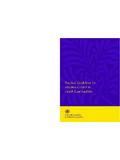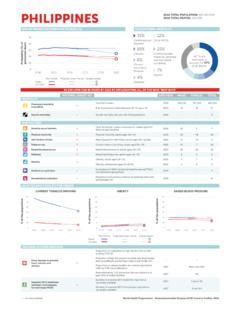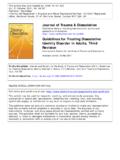Transcription of GUIDELINES for Centers and Groups International Sathya Sai ...
1 GUIDELINES for Centers and Groups International Sathya Sai organization September 2012 The Organisations named after Me are not to be used for publicising My Name or creating a new cult around My worship. They must try to spread interest in recitation of God's Name, meditation, and other spiritual exercises that lead man Godward. They must demonstrate the joy derivable from devotional singing and remembering the Lord's Name, the peace that one can draw from good company. They must render selfless service to the helpless, the sick, the distressed, the illit-erate, and the needy. Their service should not be exhibitionistic; it must seek no reward, not even gratitude or thanks from the recipients. [ ] Sathya Sai Baba The main objective of the Sathya Sai Organisation .. is to help humanity recognize its inherent divinity.
2 So, your duty is to emphasise the One, to experience the One in all you do and speak. Do not give any importance to differences of religion, sect, status, or color. Have the feeling of One-ness permeate all your acts. Only those who do so have a place in this Organisation; the rest can withdraw. [ ] Sathya Sai Baba It is not correct to say that you like only Rama or Krishna or Siva or Sai Baba. There is only one God, and He is omnipresent. Do not hate other religions. A Hindu should become a better Hindu, a Christian a better Christian, and a Muslim a better Muslim.. You will find the unity of all re-ligions only when you fill your heart with love. [ ] Sathya Sai Baba The symbol on the front cover is the logo of the International Sathya Sai organization . It con-tains the five universal values given to us by Sathya Sai Baba: truth ( Sathya ), right conduct (dharma), inner peace (santhi), divine love (prema), and nonviolence (ahimsa).
3 The tall pillar with a lotus flower on it in the middle is called the sarva dharma stupa. The pillar, with its con-centric rings, represents yoga, or union with God. The rings indicate the stages of yogic disci-pline required for unfolding the lotus of the heart , whose petals are at the top of the pillar. The flame of inner illumination is in the center of the lotus. Just as the lotus plant lives in dirty water but remains uncontaminated by it, so we should live in the world but be uncontaminated by it. This logo was adopted in 2006. Prior to that, a logo depicting either five or six World Reli-gions was used. These logos, together with the name Sri Sathya Sai Baba (and variations of it), have been trademarked in many countries in order to protect them from misuse. See GUIDELINES for Centers and Groups of the International Sathya Sai organization 2 Table of Contents 1.
4 INTRODUCTION .. 3 2. PURPOSE OF THE International Sathya SAI organization .. 3 3. MEMBERSHIP REQUIREMENTS .. 3 Nine-point code of conduct .. 4 Ten guiding principles .. 4 4. STRUCTURE OF THE organization .. 4 World Foundation .. 5 Prasanthi Council .. 5 Zones, regions, and countries .. 5 5. PROGRAMS AND PRACTICES .. 7 The Sathya Sai center .. 7 One-pointed orientation .. 7 Three wings of the Sathya Sai center .. 7 Devotion wing .. 8 Education wing .. 8 Service wing .. 8 center library .. 9 Officers of a center .. 9 Young-adult program .. 9 6. TYPES OF MEETINGS .. 9 Regular meetings .. 9 Membership meetings .. 10 Guest meetings .. 10 Public meetings .. 10 Sai conferences and retreats .. 10 7. SAI EDUCATION INITIATIVES OUTSIDE THE Sathya SAI center .. 11 Institutes of Sathya Sai Education.
5 11 Sathya Sai Schools .. 11 SSEHV in community settings .. 12 SSEHV for teens and young adults .. 12 Sathya Sai parenting .. 12 8. FINANCIAL MATTERS .. 12 9. WEBSITES .. 13 GUIDELINES for Centers and Groups of the International Sathya Sai organization 3 1. INTRODUCTION The International Sathya Sai organization and the All India Sri Sathya Sai Seva organization were officially formed through a Charter granted by Bhagavan Sri Sathya Sai Baba on 14 Janu-ary In 2010, after receiving approval from Sathya Sai Baba, the Sri Sathya Sai World Foundation formed the GUIDELINES Committee to review the GUIDELINES currently in use in the various geo-graphical Zones of the world in order to develop one set of GUIDELINES applicable to all the coun-tries outside India. The committee s work was also guided by the recommendations that came from the Ninth World Conference of Sathya Sai Organizations held at Prasanthi Nilayam in No-vember 2010 as well as the pre-world conferences held around the globe in 2010.
6 The present document is a general one that describes the programs and practices of the Sath-ya Sai Centers and Groups2 of the International Sathya Sai organization . While intended for use by office bearers and members of the organization , it is also suitable for persons interested in joining the organization and other members of the public. A more extensive corollary document, the Operations Manual for Centers and Groups , de-scribes in detail the duties and responsibilities of officers as well as the rules and regulations that apply to the various programs conducted by Centers . A third document will give GUIDELINES , rules, and regulations that apply at the country, region, and zone levels. 2. PURPOSE OF THE International Sathya SAI organization The main objective of the Sathya Sai Organisation.
7 Is to help humanity recognize its inherent divinity. [ ] It is established to translate the principles of love and nonviolence into daily practice. [ ] Sathya Sai Baba The primary purpose of the International Sathya Sai organization is to promote in its mem-bers ever-increasing faith in God, along with the recognition of the inherent Divine Nature of human beings and all of God s creation. The Sathya Sai center , consisting of members in a local community, is the principal instru-ment through which this goal is achieved. The center provides a loving environment that nour-ishes the devotion of its members by creating opportunities to study and practice the teachings of Sathya Sai Baba. The functions of a center are described later in this document. 3. MEMBERSHIP REQUIREMENTS The qualifications for membership are to be an eager aspirant for spiritual progress, to have full faith in the name that the Organisation bears.
8 , and to have won recognition as a good person. That is all the qualification needed; nothing else counts. [ ] Sathya Sai Baba 1 The Charter can be found here: 2 A Sathya Sai center must have at least nine members and must conduct the program activities in at least two of the three wings : devotion, education, and service. Otherwise, the designation Sathya Sai group is used. Throughout this document, we use center for both Centers and Groups . GUIDELINES for Centers and Groups of the International Sathya Sai organization 4 There are no dues or membership fees, and donations are never solicited. An individual who is at least 18 years old3 may become a member of a Sathya Sai center after having become fa-miliar with these GUIDELINES and after expressing a sincere intention to practice them. Members of the International Sathya Sai organization are expected to do their best to prac-tice the Nine-Point Code of Conduct and the Ten Guiding Principles laid down by Sathya Sai Baba and thereby become exemplars of His teachings.
9 Nine- point code of conduct (From the original Charter of the organization .) 1. Daily meditation and prayer. 2. group devotional singing or prayer with family members once a week, where possible. 3. Participation in Sai Spiritual Education by children of the family. 4. Regular attendance at the center s (at least once per month) devotional meetings. 5. Participation in community service work and other programs of the organization . 6. Regular study of Sathya Sai Baba literature. 7. The practice of placing a ceiling on desires consciously and continuously striving to eliminate the tendency to waste time, money, food, and energy and utilizing the sav-ings for service to mankind. 8. The use of soft, loving speech with everyone. 9. Not speaking ill of others, especially in their absence. Ten guiding principles (Given by Sathya Sai Baba in his discourse on ) 1.
10 Love and serve your country. Do not be critical of others' countries. 2. Honor all religions, for each is a pathway to the one God. 3. Love all people without distinction; know that humanity is a single community. 4. Keep home and surroundings clean. 5. Help people to become self-reliant. Provide food and shelter, love and care, for the sick and the aged. 6. Do not tempt others by offering bribes or demean yourself by accepting them. 7. Do not develop jealousy, hatred, or envy on any account. 8. Do not depend on others to serve your personal needs; become your own servant before proceeding to serve others. 9. Adore God, abhor sin. 10. Observe your country's laws and be exemplary citizens. 4. STRUCTURE OF THE organization The structure designed to effectively administer the affairs of the organization is as follows: 3 In countries in which people younger than 18 may choose membership in religious communities, the zone chair, after consultation with the Prasanthi Council, may set an appropriate lower age.








